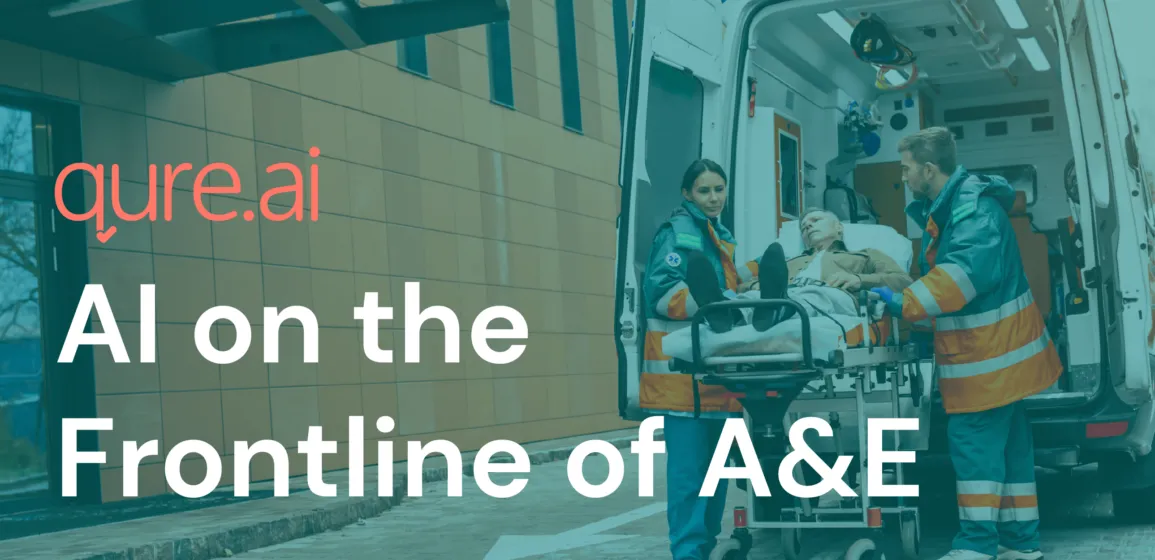Demand for access to the front door of healthcare services for severe injuries and life-threatening conditions has reached unprecedented levels in the UK. Accident and Emergency (A&E) or Emergency Departments (ED) are continually challenged to meet the operational standards set in 2010 that at least 95% of patients attending A&E should be admitted, transferred, or discharged within four hours.

Back
While performance data in summer months paint a relatively optimistic picture, come the winter, when patient profiles change to a more significant proportion of older people attending and requiring emergency admission, the scenes of critical winter A&E incidents of backed-up ambulances and trolley waits in corridors may return.
The reasons for A&E pressures are complex, from a perfect storm of elements impacting the flow of patients across the whole health and care continuum. Yet incremental departmental gains can be achieved by implementing innovative digital health and Artificial Intelligence (AI) systems.
Creating calm and clarity in critical situations
No patient or family relative wants to be in a hectic, loud, and busy emergency environment for hours on end. And the pressures of patient demands have also taken their toll on staff, who find working in an increasingly challenging environment draining, with retention and recruitment rates being challenged.
Can AI be a panacea for streamlining throughput and supporting clinicians with rapid diagnostic decision-making and case prioritization?
AI to help speed up chest X-ray reporting
In the Southeast of England, East Kent Hospitals serve a patient population of over 700,000 people. It is now using qXR AI software to help check chest X-rays for patients in its emergency departments.
The solution can spot potential issues almost instantly and alert doctors, reducing any likely delay in starting treatment. It means issues such as cancer, collapsed lungs and tuberculosis can possibly be detected quickly without waiting for a radiologist or expert reporting radiographer to review the images.
Dr. Neelan Das, Consultant Interventional Radiologist, and AI lead for the Trust, said there were clear benefits for patients and emergency department staff, “It [AI] has real potential to improve patient care and outcomes and to reduce delays in our emergency departments. The technology allows for faster interpretation and targeted reporting of the images so that any abnormalities can be flagged immediately for the doctor to review. Our initial testing has shown that it is at least as sensitive as a senior radiologist and when it is rolled out fully across our emergency departments it could analyse thousands of x-rays every month.”
AI to analyse head CTs for faster decision-making
Similarly, the potential of AI for neurocritical patients admitted following trauma incidents or suspected strokes is gaining momentum to deliver faster decision-making and timely treatment planning.
In partnership with Blackford, Milton Keynes University Hospital NHS Foundation Trust has just gone live with qER, Qure’s neurocritical AI.
The Trust sees and treats more than 400,000 outpatients and over 100,000 emergency department patients each year, in addition to delivering a wide range of elective (planned) and non-elective procedures. It will use Qure’s qER to automate the detection of critical and life-threatening abnormalities in head CT scans, including intracranial haemorrhages (ICH) caused by trauma, accidents, or strokes. This will aid the triage of critical cases, within three minutes, in the emergency department, especially during out-of-hour shifts when a larger team may not be available.
Andrew Scott, PACS Manager / Imaging IT Systems Lead Imaging Department of Milton Keynes University Hospital NHS Foundation Trust explains, “Our collaboration with Blackford and Qure.ai empowers our Emergency Department with AI to swiftly identify critical head CTs scans, enabling us to prioritise and provide timely care to those who require it most. By harnessing the power of AI, we can improve clinical workflow efficiency therefore ensuring that we deliver the safest and most effective care for all of our patients.”
AI to swiftly identify normal or abnormal MSK fractures
Suspected bone fractures make up a good proportion of patients waiting in the Emergency Department. So, imagine a scenario where X-rays are read automatically by AI and cases are flagged to clinicians as normal for quick reviews and patients are discharged out of the busy department, or as abnormal, requiring next-stage care or referral.
qMSK aids in detecting bone fractures and joint dislocations of multiple body parts on X-rays in less than a minute.
Patient waiting times at the front door of UK healthcare, and departments beyond, will not be solved overnight. Yet with continued strategic focus nationally, and NHS confidence in AI as tool to support patients and clinicians, the future presents some compelling efficiency and value gains.